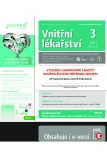Pembrolizumab-induced hypothyreosis and subcutaneous bleeding
Authors:
Pavel Polák 1,3,4; Jana Špeldová 2; Monika Bratová 2; Jiřina Zavřelová 1,3; Miroslav Penka 1
Authors‘ workplace:
Oddělení klinické hematologie, Fakultní nemocnice Brno
1; Klinika nemocí plicních a tuberkulózy, Fakultní nemocnice Brno
2; Katedra laboratorních metod, Lékařská fakulta Masarykovy univerzity Brno
3; Interní hematologická a onkologická klinika, Fakultní nemocnice Brno
4
Published in:
Vnitř Lék 2021; 67(3): 175-179
Category:
Case reports
Overview
Pembrolizumab belongs to so called immune checkpoint inhibitors. Frequent adverse event of this therapy is hypothyroidism. The authors present a case report of patient treated with pembrolizumab for non-small cell lung carcinoma, in whom severe hypothyroidism followed quite rapidly after transient phase of subclinical hyperthyroidism – at this time point new and spontaneous onset of large subcutaneous hematomas was observed. Acquired von Willebrand syndrome, acquired hemophilia A, dysfibrinogenemia, activation of fibrinolysis and thrombocytopathy were all actively ruled out in hematological differential diagnosis. Concomittantly, laboratory markers of secondary autoimmune disease and myositis were excluded. Despite continuous pembrolizumab treatment, there were no other bleeding complications seen after intensification of endocrine substitution therapy with thyroid hormones. Causal relationship between subcutaneous hematomas and severe drug-induced hypothyroidism is established per exclusionem.
Keywords:
hematomas – Hypothyroidism – pembrolizumab
Sources
1. Si X, Song P, Ni J et al. Management of immune checkpoint inhibitor-related adverse events: a review of case reports. Thoracic Cancer 2020; 11: 498–504.
2. Presotto EM, Rastrelli G, Desideri I et al. Endocrine toxicity in cancer patients treated with nivolumab or pembrolizumab: results of a large multicentre study. J Endocrinol Invest 2020; 43 (3): 337–345.
3. Girotra M, Hansen A, Farooki A et al. The current understanding of the endocrine effects from immune checkpoint inhibitors and recommendations for management. JNCI Cancer Spectrum 2018; 2(3): 1–9.
4. Olsson-Brown A, Lord R, Sacco J, et al. Two distinct clinical patterns of checkpoint inhibitor- induced thyroid dysfunction. Endocrine Connections 2020; 9: 318–325.
5. Delivanis DA, Gustafson MP, Bornschlegl S et al. Pembrolizumab-induced thyroiditis: comprehensive clinical review and insights into underlying involved mechanisms. J Clin Endocrinol Metab 2017; 102(8): 2770–2780.
6. Williams H, Aitchison R. Pembrolizumab-induced autoimmune haemolytic anaemia and cholangitis. BMJ Case Rep 2019; 12(12): pii:e232505.
7. Johnstone P, Khan O. Pembrolizumab-associated autoimmune haemolytic anaemia. BMJ Case Rep 2019; 12(10): pii:e229064.
8. Berger M, Amini-Adlé M, Crumbach L et al. A case of immune thrombocytopenia induced by pembrolizumab in a metastatic melanoma patient with a history of immune- -mediated pure red cell aplasia. Eur J Cancer 2019; 112: 94–97.
9. Le Roy A, Kempf E, Ackermann F et al. Two cases of immune thrombocytopenia associated with pembrolizumab. Eur J Cancer 2016; 54: 172–174.
10. Isoda A, Miyyazawa Y, Tahara K et al. Pembrolizumab-induced pure red cell aplasia successfully treated with intravenous immunoglobulin. Intern Med 2020; 59(16): 2041–2045. doi: 10.2169/internalmedicine .4467–4520.
11. Kunimasa K, Nishino K, Kimura M et al. Pembrolizumab-induced acute thrombosis. Medicine (Baltimore) 2018; 97(20): e10772.
12. Huang AC, Postow MA, Orlowki RJ et al. T-cell invigoration to tumour burden ratio associated with anti-PD-1 response. Nature 2017; 545: 60–65.
13. Sanchez A, Montaudie H, Bory P et al. Antiphospholipid syndrome following pembrolizumab treatment of stage IIIB unresectable melanoma. JAMA Dermatol. 2018; 154(11): 1354–1356. doi:10.1001/jamadermatol.2018.2770.
14. Rao BB, Robertson S, Philpott J. Checkpoint inibitor-induced hemorrhagic gastritis with pembrolizumab. Am J Gastroenterol 2019; 114 (2): 196. doi:10.1038/s41395-018-0366-3.
15. Sugano T, Seike M, Noro R et al. A case of interstitial lung disease with alveolar hemorhage induced by pembrolizumab. Onco Targets Ther 2018; 17(11): 5879–5883.
16. Artal-Cortés A, Felices-Lobera P, Márquez-Medina D. Massive hemoptysis after the first administration of pembrolizumab in a strongly positive, centrally located NSCLC. J Thorac Oncol 2018; 13(5): e76–e77.
17. Elbers LPB, Fliers E, Cannegieter SC. The influence of thyroid function on the coagulation system and its clinical consequences. J Thromb Haemost 2018; 16(4): 634–645.
18. Franchini M, Montagnana M, Manzato F et al. Thyroid dysfunction and hemostasis: an issue still unresolved. Semin Thromb Hemost 2009; 35(3): 288–294.
19. Soni S, Singh G, Yasir S et al. An unusual presentation of hypohyroidism. Thyroid 2005; 15(3): 289–291.
20. Federici AB. Acquired von Willebrand syndrome associated with hypothyroidism: a mild bleeding disorder to be further investigated. Semin Thromb Hemost 2011; 37(1): 35–40.
21. Kyriakakis N, Lynch J, Ajjan R et al. The effects of pituitary and thyroid disorders on haemostasis: potential clinical implications. Clinical Endocrinology 2016; 84: 473–484.
Labels
Diabetology Endocrinology Internal medicineArticle was published in
Internal Medicine

2021 Issue 3
Most read in this issue
- What's new in the 2020 update of the CEAP classification system of chronic venous disease?
- Vericiguat in patients with heart failure and reduced ejection fraction
- The use of moxonidine in the treatment of arterial hypertension
- Treatment strategies for myelodysplastic syndrome in 2021
